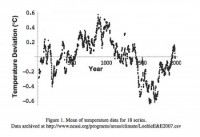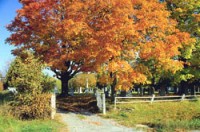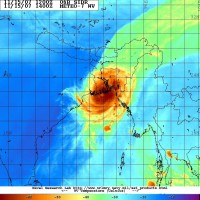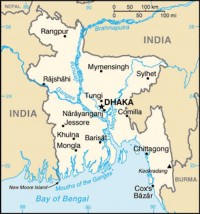By Andrew Bolt, Herald Sun
The IPCC used it (the ‘hockey stick") in its third assessment report. Al Gore used it in his movie. In fact, no graphic has had such a huge effect as the infamous hockeystick produced by Michael Mann, who used tree ring data to allegedly show that the last century’s warming was unprecedented, and the globe had never in 2000 years been this hot.
Small problem. Mann’s manipulation of the statistics has since been discredited, and the graph dropped out of the IPCC’s fourth report. But the damage has been done. Millions of people now firmly believe the world hasn’t been this hot in recorded history, not even during the Medieval Warm Period. Now a new study says Mann didn’t just get the maths wrong, but could have been using tainted data as well. Ecological modeller Dr Craig Loehle has checked other proxy data, rather than the tree rings he says are unreliable, and comes up with a very different graphic indeed:

Says Loehle: “There are reasons to believe that tree ring data may not properly capture long-term climate changes. In this study, eighteen 2000-year-long series were obtained that were not based on tree ring data. Data in each series were smoothed with a 30-year running mean. All data were then converted to anomalies by subtracting the mean of each series from that series. The overall mean series was then computed by simple averaging. The mean time series shows quite coherent structure. The mean series shows the Medieval Warm Period (MWP) and Little Ice Age (LIA) quite clearly, with the MWP being approximately 0.3°C warmer than 20th century values at these eighteen sites.” To sum up. This warming is not unusual. The planet was warmer less than 1000 years ago. Oh, and see the fall in temperatures since 1998’s high, which so panicked so many people. Read more here.
By Noel Sheppard, Newsbusters
Is the press beginning to see through Al Gore’s global warming scam?
A brief article posted at Newsweek’s website offers hope that the media might finally be recognizing the former Vice President could be this decade’s Ken Lay. For those that have forgotten, Lay was the CEO of Enron.
Since 2000, according to published reports, the former veep has transformed himself from a public servant with around $1 million in the bank to a sparkling private consultant with a net worth estimated to be north of $100 million. He’s a senior adviser to Google, a board member at Apple and now a newly minted general partner at Kleiner Perkins Caufield & Byers, the Silicon Valley venture-capital firm that made billions investing early in Netscape, Amazon and Google. Read more here.

By Ray Harvey, Fort Collins Forum Correspondent
On October 19, 2007, the Rocky Mountain News ran an op-ed piece entitled “Al Gore’s ignoble Nobel,” by Denver talkshow host Mike Rosen. Five days after that, a rebuttal appeared. This rebuttal, “Mostly wrong on warming,” was written by a scientist named Kevin Trenberth, head of the Climate Analysis Section at the National Center for Atmospheric Research in Boulder. In turn, Dr. Trenberth’s article was rebutted by a man named Christopher Monckton, third viscount of Benchley and former advisor to Margaret Thatcher. Mr. Trenberth’s article did not appear in the Rocky Mountain News; it was published on the Science and Public Policy website.
Mr. Monckton, who, like Mike Rosen (and Al Gore), is not a scientist, then appeared as a guest on Mike Rosen’s radio show, to discuss in greater detail what he calls the “swindle” of global warming. It should also be noted that Dr. Trenberth was invited on the program to debate the issue with Mr. Monckton, but, as you might suspect, Trenberth declined – and did so, according to Mike Rosen’s producers, none too politely.
Among global warming alarmists, it’s become somewhat vogue to criticize the “credentials” of anyone, scientist and non-scientist alike, who disagrees with the catastrophic scenarios. Turnabout, then, is only fair play. Quoting MIT climatologist Dr. Richard Lindzen: “But there is a more sinister side to this feeding frenzy. Scientists who dissent from the alarmism have seen their grant funds disappear, their work derided, and themselves libeled as industry stooges, scientific hacks or worse. Consequently, lies about climate change gain credence even when they fly in the face of the science that supposedly is their basis.”
As Mr. Lindzen notes in the above-quoted passage, government-funded scientists depend entirely upon politicians for their research money. Science, therefore, which by definition is an objective discipline, is instantly politicized: i.e. science is made non-objective. Science becomes a thing of consensus – which by definition means that science is no longer science. Instead of rational debate and scientific inquiry, we’re subject to these endless lobby campaigns, these endless invectives, these endless personal smears against any scientist who dares to do her job — question and investigate — and this is the reason we now hear the constant authoritarian cry: “Silence! The debate is over.” This kind of ad hominem attack is many things, but science is certainly not one of them. Read more here.
By Andrea Thompson, LiveScience Staff Writer
A gray, grim landscape used to greet residents of the Northeastern United States each November, but autumn’s riot of red, orange and yellow came late this year. Delayed fall foliage also occurred in Chicago and parts of Europe.

Some say droughts and a warm summer played a role, while others wonder more broadly about global warming. In fact, it’s rising levels of carbon dioxide, not the warmer temperatures fueled by the greenhouse gas, that have been delaying the transformation of green leaves, at least in Europe for a few decades, a new study suggests.
The researchers found that trees exposed to elevated levels of carbon dioxide retained their leaves and stayed greener longer than those exposed to ambient levels. Their results are detailed in an online edition of the journal Global Change Biology. “The research data provide compelling evidence ... that autumnal senescence in such forest ecosystems will be delayed as the atmospheric concentration of CO2 continues to rise, independent of increased temperatures,” said study author Gail Taylor. Read more here.
Associated Press
A cyclone killed over 2000 people and left much of southern Bangladesh cut off from the rest of the country before heading inland and losing strength Friday, officials said. Tropical Cyclone Sidr roared across the country’s southwestern coast late Thursday with driving rain and high waves, spawning a 4-foot water surge that left low-lying areas and some offshore islands under water, according to Nahid Sultana, an official at a cyclone control room in the capital, Dhaka. But by early Friday, the cyclone had weakened into a tropical storm and was moving across the country to the northeast, the department said, adding that while skies remained overcast, wind speed had fallen to 37 mph.

Bangladesh, a low-lying delta nation, is prone to seasonal cyclones and floods that cause huge losses of life and property. The alluvial plain in Bangladesh is probably the worst place in the world for a storm surge. May inlets lead to a funneling of the storm surge well inland.

Icecap notes: The 1991 Bangladesh cyclone Gorky killed at least 138,000 people and leaving as many as 10 million homeless as it roared inland with 155 mph winds and a 20 foot storm surge. In November of 1970 devastating tropical cyclone Bhola struck Bangladesh (at that time East Pakistan) and India’s West Bengal. It was the deadliest tropical cyclone ever recorded, and one of the deadliest natural disasters in modern times. Up to 500,000 people lost their lives in that storm.
By James Delingpole: Thunderer, Times Online
First there came the computer-generated polar bear in Al Gore’s An Inconvenient Truth; then that heartrending photo, syndicated everywhere, of the bears apparently stranded on a melting ice floe; then the story of those four polar bears drowned by global warming (actually, they’d perished in a storm). Now, in a new cinema release called Earth – a magnificent, feature-length nature documentary from the makers of the BBC’s Planet Earth series – comes the most sob-inducing “evidence” of all: a poor male polar bear filmed starving to death as a result, the quaveringly emotional Patrick Stewart voiceover suggests, of global warming.
Having been up to the bears’ habitat in Svalbard, I do have a certain amount of sympathy with these concerns. To claim, however, that they are facing imminent doom is stretching the truth. In 1950, let us not forget, there were about 5,000 polar bears. Now there are 25,000. No wonder Greenpeace had trouble getting polar bears placed on the endangered species list. A fivefold population increase isn’t exactly a catastrophic decline. But never let the facts get in the way of a good story. The doom-mongers certainly won’t. Despite evidence from organizations such as the US National Biological Service that in most places polar bear populations are either stable or increasing, Ursus maritimus will continue to top the eco-hysterics’ list of animals in danger because it’s so fluffy and white and photogenic.
If you’re really that worried about their demise, I’d book yourself a ticket to Churchill, Manitoba, where the evil buggers (about the only creature, incidentally, that actively preys on humans) are so rife they’re almost vermin. Read more here.

By Paula Easley, Anchorage Daily News
Reading about the recent global warming rally at Kincaid Park, I wondered if the participants would be relieved if man’s activities were proved not responsible for Alaska’s warming weather. An intriguing question.
They probably don’t know ground-based warming stopped in 1998, according to Intergovernmental Panel on Climate Change data. This temperature stability is occurring despite a four percent increase in atmospheric C02 over the last eight years. Lower atmosphere satellite data also show little, if any, warming since 1979, although atmospheric CO2 increased 17 percent.
In another surprising turn, NASA’s Goddard Institute for Space Studies corrected data errors this September that required changing America’s warmest year on record from 1998 to 1934, thus refuting the Gospel According to James Hansen, the Institute’s director. The third hottest year is now 1921.
Ancient Chinese records have revealed historic warming from year one to about A.D. 240 (the Roman Warming); a cold period between years A.D. 240 and 800 (Dark Ages); warming between 800 and 1400 (Medieval Optimum); and cooling from 1400 to about 1900 (Little Ice Age). Where were man-made CO2 emissions then? Contrary to today’s predictions of catastrophic weather events, during China’s warm periods it experienced fewer and milder storms, fewer droughts and floods, better crops and more prosperity. Here at home, researchers found serious droughts are becoming rare. According to www.CO2Science.org, seven droughts occurred before 1920, seven from 1921-1940 (including the Dust Bowl disaster), eight from 1941-1960, five from 1961-1980 and just three during the next two decades.
But people are dying because of global warming, prominent climate alarmist Deborah Williams wrote (ADN, April 18, 2006), noting 31,000 Europeans died in the 2003 heat wave. Yet cold kills many times more people than heat (as Alaskans well know). Cold weather in England and Wales, 1998-2000, caused some 47,000 deaths each winter. Read more of Paula’s story here.
By Steve McIntyre, Climate Audit
In recent discussion of the Weblog 2007 Awards, several commenters at other blogs have argued that our criticisms of the Mannian parlor tricks have been “thoroughly refuted and discarded by climatologists, published in a credible journal”; that “other professionals in the field who also have “looked in great detail at the problem at hand” and have come to the conclusion that rather than McIntyre’s findings being “valid and relevant”, they instead have found them to be “without statistical and climatological merit”; that CA “fluffed on the whole hockey stick thing”.
Omitted in these references are the fact that the people described as “climatologists published in a credible journal” or “professionals in the field” are none other than Wahl and Ammann, serial coauthors with Michael Mann, students of Mann, who are not independent of the controversy. Indeed, they largely use (without citation or attribution or even acknowledgment to Michael Mann) arguments originally published at realclimate (and already responded to in MM 2005b(EE). Aside from their lack of independence, neither Ammann nor Wahl qualify as statistical authorities. Ammann did his undergraduate work in geology; Wahl in divinity. While this does not exclude them from having potential insight in the matter, it is evidence that one should not necessarily expect a sure grasp of mathematical and statistical issues and that their conclusions cannot be relied upon uncritically, even if Stephen Schneider accepted their article. Read more from Steve recapping the history of the totally debunked hockey stick here.
Icecap Note: Congratulations to Steve and Climate Audit to see his hard work rewarded with a virtual tie with Bad Astronomy blog for Best Science Blog 2007.


